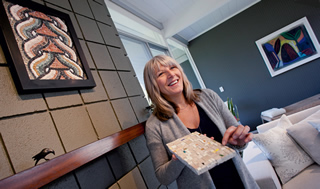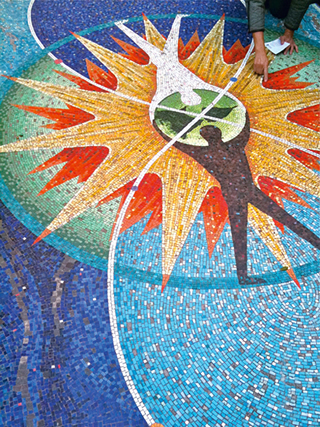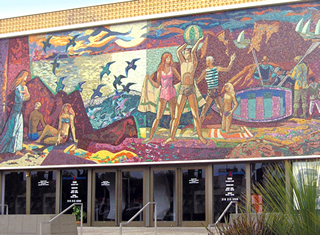Art Goes to Pieces - Page 2
 |
|
|
 |
|
|
In Sacramento, Wayne Thiebaud, later better known for paintings of pies, covered much of the municipal utility district’s building in 1959 with a startling play of colored glass tiles.
In Oakland, mosaic artist Louisa Jenkins, working with students in 1957, placed a marvelously three-dimensional mural of glass, tile, and stone on an exterior wall of the brand-new Holy Names College, designed by modern architect Milton Pflueger.
In the East Bay town of El Cerrito, architect Henry Hill, known for his gold-leaf ceilings and quirky color sense, topped an indoor swimming pool with a hanging Tiki-style boat and surrounded it with panels of abstract mosaic that suggest the sea.
 |
|
|
In San Francisco’s Bay View district, mosaicist Anthony Stellon created a wonderful mural, ‘Brotherhood of Man,’ for the Martin Luther King, Jr. swimming pool in 1968.
And in Mexico, whose mosaic tradition heavily influenced events in the United States, Juan O’Gorman bathed several buildings at the University of Mexico in a mosaic of lava rock that he said evoked the “profusion of form and color, which was characteristic of the ancient art of Mexico.”
O’Gorman, who trained as an architect, inveighed against “the Puritanism of architecture today,” an attitude he clearly shared with Anshen and Allen, who believed International Style architecture could become rote and joyless, and the theatrically inclined Henry Hill.
“During the late 1950s to mid-1970s,” wrote Lillian Sizemore, a mosaic artist who lives in an Eichler home in Marin’s Lucas Valley, “there was a major movement of abstract and modernist imagery used to embellish architectural settings, rising out of the WPA [Works Progress Administration from the 1930s] and Mexican muralist movement.”
But what about the modernist ethos that ‘applied ornament’ was inimical to true architecture—that beauty on a building should come only from its structure and material?
 |
|
|
 |
|
|
Clute pooh-poohed the concern. “Mosaic fits into our architecture,” he wrote, “because it does not break the surface, but is an integral part of it, and it is a versatile means of expression.”
Today, almost any tour of mid-century modern buildings, from college campuses and libraries to banks and downtown shopping districts, will reveal a surprising number of mosaic murals. A quick web search will find hundreds of mosaic panels from the era for sale.
And mosaic aficionados don’t have to restrict their search to vintage dealers. Over the past few years, mosaics have undergone a resurgence, says Sonia King, who splits her time between San Francisco and Dallas and helped found the Society of American Mosaic Artists in 1998.
In San Francisco, King lives in a strikingly open mid-century modern home that floats above a steep hillside.




